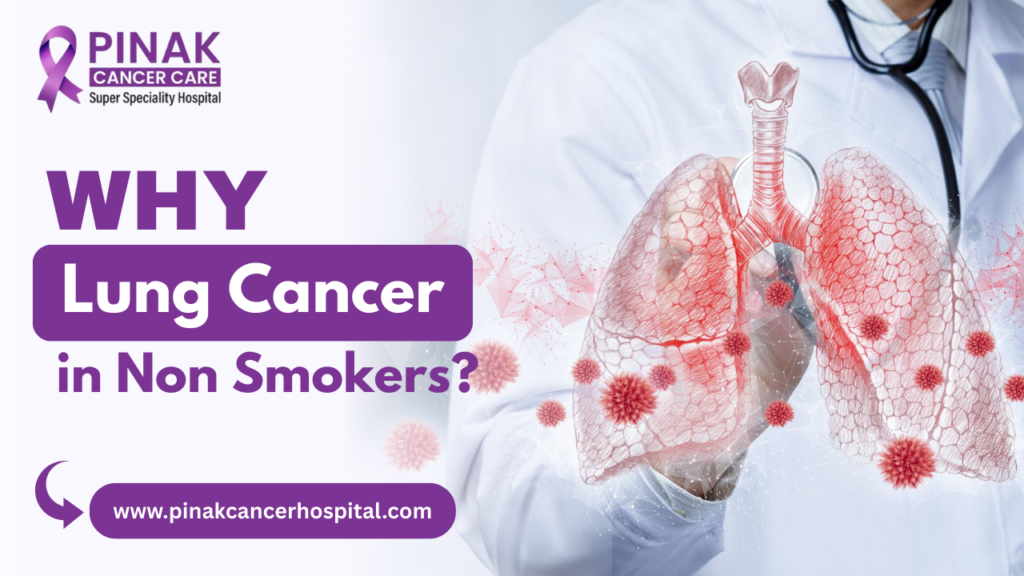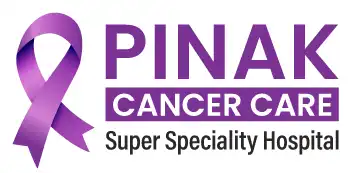
Lung cancer is often associated in the public mind with smoking, but a growing number of lung cancer patients never smoked or smoked very little. This fact is alarming because many non-smokers and their families are not aware of the risks, and early symptoms can be missed. In Varanasi and across India, the incidence of lung cancer in non-smokers is rising, driven by environmental, genetic, occupational, and lifestyle factors.
This post explores the causes of lung cancer in non-smokers—why it happens, risk factors to be aware of, how to detect it early, and what’s being done locally at Pinak Cancer Care & Superspeciality Hospital to provide diagnosis, treatment, and support.
What We Mean by “Non-Smoker”
Before diving into causes, it’s useful to define “non-smoker” in the medical context:
- A “never-smoker” is someone who has smoked fewer than 100 cigarettes in their lifetime (or the equivalent in cigars, bidis, etc.).
- Sometimes, someone who quit many years ago may also be considered differently depending on latency and risk.
- Also, “non-smokers” may nevertheless be exposed to second-hand smoke, indoor pollutants, etc., which complicates risk definitions.
Why Lung Cancer in Non-Smokers Is Rising
Multiple studies in India and globally have shown that 10-30% (or sometimes more) of lung cancer cases occur in non-smokers. Some of the key environmental and genetic risk factors are better recognized now, though awareness remains lower than optimal.
Why Non-Smoker Lung Cancer Often Gets Detected Late
Many non-smokers or their doctors may not suspect lung cancer early, because:
- Symptoms (persistent cough, breathlessness, coughing blood, unexplained weight loss, and chest pain) are often mild or attributed to other common illnesses like TB or bronchitis.
- There is less awareness that even non-smokers are at risk.
- Screening protocols are often targeted at smokers or high-smoking populations, so non-smokers may not be getting low-dose CT scans or other imaging until the tumor is large.
- Lack of access to diagnostic facilities or delays in referral.
Role of Pinak Cancer Care & Superspeciality Hospital, Varanasi
Pinak Cancer Care & Superspeciality Hospital is among Varanasi’s leading cancer treatment centres. It offers comprehensive services: diagnostics, multidisciplinary treatment (surgery, chemotherapy, radiotherapy, and immunotherapy), patient support, and follow-ups. The hospital maintains standards focused on early detection, patient-centred care, and the use of modern technology.
What Pinak Does to Tackle Lung Cancer in Non-Smokers
Here are some of how Pinak addresses these challenges (based on general good practices and what is expected from a superspeciality cancer hospital; you may cross-check for the hospital’s specific features):
1. Diagnostic facilities
-
- High-resolution imaging (CT, PET-CT) to pick up suspicious nodules early.
- Bronchoscopy and biopsy (including guided needle biopsy) to get tissue diagnosis.
- Molecular/genetic testing (e.g. for EGFR, ALK, etc.) so that even non-smokers who are likely to have these mutations can get targeted therapy.
- High-resolution imaging (CT, PET-CT) to pick up suspicious nodules early.
2. Multidisciplinary tumour boards
-
- Pulmonologists, thoracic surgeons, medical oncologists, radiation oncologists, and pathology experts meet to plan personalized treatment.
- Non-smoker cases often need special planning, because their tumor biology may differ.
- Pulmonologists, thoracic surgeons, medical oncologists, radiation oncologists, and pathology experts meet to plan personalized treatment.
3. Treatment options
-
- Targeted therapy: For patients with specific mutations.
- Immunotherapy: where applicable.
- Modern radiotherapy techniques that spare more normal lung tissue.
- Minimally invasive surgical methods if feasible.
- Targeted therapy: For patients with specific mutations.
4. Preventive awareness & outreach
-
- Public health education: about risk from pollution, biomass fuel, second-hand smoke, etc.
- Encouraging people with symptoms (even without a smoking history) to get checked.
- Helping reduce indoor pollutants, better ventilation, clean cooking fuels etc.
- Public health education: about risk from pollution, biomass fuel, second-hand smoke, etc.
5. Support services
- Palliative care for advanced cases.
- Nutritional support, counseling, and follow-up care.
Pinak, by virtue of being a superspeciality hospital, is well placed to deliver all of this in Varanasi, a city with both urban pollution and rural surroundings where biomass fuel usage is still present.
Prevention & Early Detection
Even though some risk factors are beyond individual control (genes, geography, etc.), there are many steps you can take to reduce the risk or help detect lung cancer earlier:
- Improve air quality indoors: Use clean cooking fuels, ensure a chimney or exhaust, and cook in well-ventilated spaces.
- Reduce exposure to secondhand smoke and residual smoke: Encourage smoke-free homes and workplaces.
- Check for radon: if you live in areas with known radon issues. Seal cracks in your home’s foundation, and improve ventilation.
- Use protective equipment: if you work in environments with asbestos, chemical fumes, dust, or diesel exhaust.
- Monitor lung health if you have pre-existing lung disease or frequent respiratory infections.
- Seek medical attention early for persistent symptoms: a cough that lasts more than a few weeks, coughing blood, unexplained weight loss, chest pain, and breathlessness.
- Advocate policy change: strong air quality standards, clean fuel subsidies, and better occupational safety laws.
Why It’s Important to Recognize These Causes
Varanasi faces specific environmental challenges:
- Urban pollution from traffic, industrial emissions, dust, etc.
- Use of biomass fuel in many households in the outskirts or nearby rural areas.
- Possibly, lower awareness of lung cancer in non-smokers than in metro cities.
- Healthcare infrastructure is growing, but early screening and diagnosis can still be delayed.
Emerging Research and Trends
- Studies in India show that non-smokers are being diagnosed at younger ages compared to past decades.
- Adenocarcinoma (a subtype of non-small cell lung cancer) is more common in non-smokers. It often arises in the periphery of lung tissue.
- Genetic mutation testing (EGFR, ALK, ROS1 etc.) is increasingly important for non-smokers, as these mutations are more frequent and targeted therapies yield better outcomes.
- The link between ambient air pollution and lung cancer in never-smokers has strengthened in epidemiological studies. Some large analyses estimate that a large fraction of adenocarcinomas worldwide in non-smokers are attributable to air pollution.
Book Your Appointment Today
- Address: Amara, Bypass, Awaleshpur, Akhari, Uttar Pradesh 221005
- Book an appointment 👉: PINAK CANCER CARE & Superspecialty Hospital
- Website 👉: https://pinakcancerhospital.com/
- Follow us on 👉 Instagram & Facebook.
Conclusion
Lung cancer in non-smokers is a complex and growing health issue in India. It challenges the misconception that lung cancer only affects smokers. In Varanasi, with its environmental challenges, awareness of risk factors such as air pollution, indoor smoke, radon exposure, occupational hazards, and genetic predisposition must increase.
Pinak Cancer Care & Superspeciality Hospital, with its diagnostic capabilities, modern therapies, outreach, and patient-centric care, is positioned to lead in this fight. Early detection, education, and preventive measures are key.
Frequently Asked Questions
1. If I never smoked, am I safe from lung cancer?
No. While not smoking reduces your risk significantly, it does not eliminate it. Exposure to other factors (pollution, genes, secondhand smoke, etc.) still contributes. Awareness and preventive measures are important.
What are the early warning symptoms to watch for?
-
- Persistent cough lasting several weeks or worsening cough
- Chest pain (especially when breathing deeply or coughing)
- Shortness of breath or wheezing
- Coughing up blood or rust-coloured phlegm
- Unexplained weight loss or fatigue
- Frequent respiratory infections
- Persistent cough lasting several weeks or worsening cough
3. How do non-smokers’ lung cancers differ from those caused by smoking?
-
- Often diagnosed at a later stage because of low suspicion.
- Tumor type: Non-smokers are more likely to have adenocarcinoma.
- More likely to show specific genetic mutations (EGFR, ALK etc.), which can be targeted with treatments.
- Sometimes, there is a better prognosis if detected early because there is less lung damage from smoking.
- Often diagnosed at a later stage because of low suspicion.
4. Is there a screening test for lung cancer in non-smokers?
Routine screening (like low-dose CT scans) is not widely recommended for non‐smokers unless they have other risk factors (family history, occupational exposure, etc.). But in high-risk situations, doctors may advise imaging.
5. How effective are treatments for non-smoker lung cancer?
Treatments have improved considerably, especially with targeted therapies and immunotherapy. If the tumor has actionable genetic mutations, the outcome can be much better. Early detection is still crucial for better survival.
6. Can lifestyle changes really make a difference?
Yes. Although they cannot eliminate all risk, lifestyle changes (such as improving air quality, avoiding secondhand smoke, maintaining good nutrition, engaging in physical activity, and minimising exposure to known carcinogens) can reduce risk and help the body better cope with environmental insults.
7. What is the role of genetic testing?
Very important for non-smokers: helps to tailor treatment, especially targeted agents. It may also provide information about prognosis. At hospitals with molecular diagnostic labs (like Pinak), genetic testing is part of modern lung cancer care.
